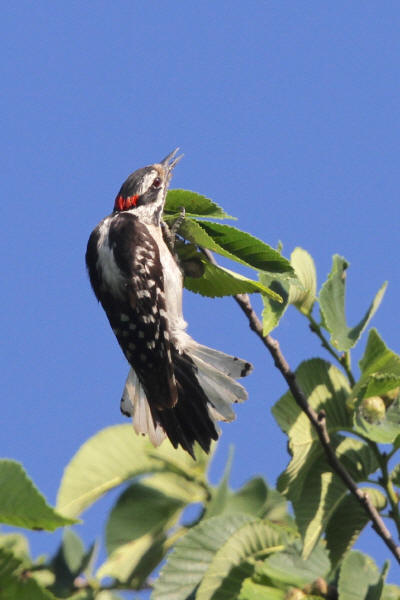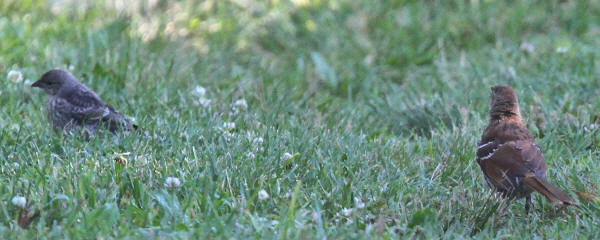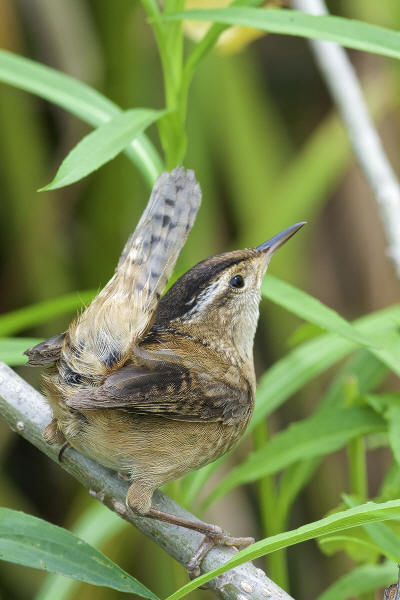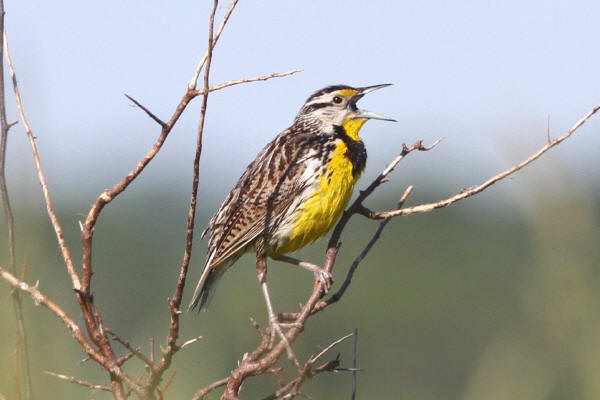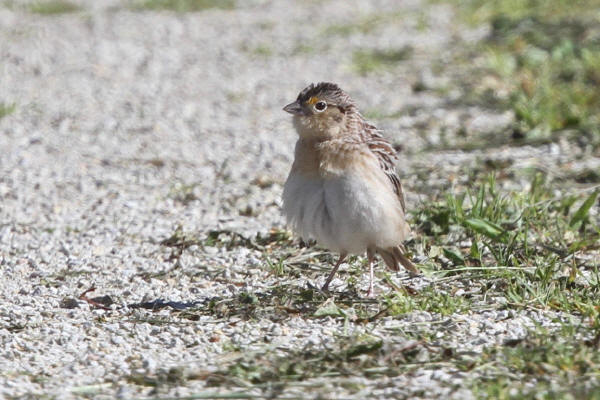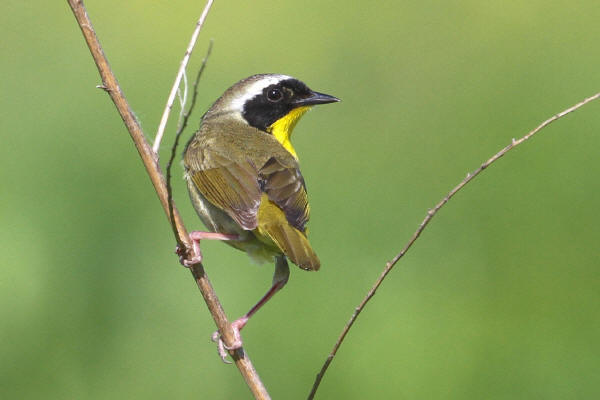Ken Schneider on 6/30 reported via e-mail: At the north end of Nelson Lake yesterday (JUN 29) Mary Lou and I found a very active Sedge Wren just as we entered the trail from the parking lot, just to the left of the first interpretive sign along the path. It was agitated and we wondered whether the mowing had disturbed or destroyed its nest. We again saw two Willow Flycatchers which acted as if they had a nest in the grove of small trees near the NW intersection of the North-South and east-west trails. Also saw Dickcissels and Bobolinks just south of the sign on the mound where the trail turns to the south. We assume that the mowing substitutes for wildfire and is intended to improve the habitat but do not know why it is carried out while prairie birds are actively nesting. Can any wildlife biologist provide the rationale? Here's a reply from Bill Graser, wildlife biologist with the KCFPD: Thank you for reaching out to
the District regarding the mowing you observed at Dick Young Forest
Preserve. I’d be happy to give you more insight about the reason behind the
mowing, and the timing as it relates to grassland bird nesting.
Sue Wagoner on 6/29 reported
via e-mail: Although unable to see the Yellow-Breasted Chat at Aurora
West F.P. I did watch this Downy Woodpecker pecking at the leaf
galls on top of a tree. Also saw this Brown Thrasher adult
accompanying its fledgling on the path.
Geraradine Baugh on 6/27
reported via e-mail: This juvenile Cooper's Hawk landed on my
deck in Hampshire Township.
Sue Wagoner on 6/22 reported via e-mail: There is a Yellow-Breasted Chat at Aurora West Forest Preserve. I heard it last night and this morning but have not yet seen it. It is in some really thick shrubs and seems quite shy. I will continue to try though. From the Indian Trail parking area turn right at the mowed path and locate the last electric tower (on the right) BEFORE the prairie area. Go a little bit beyond the tower and the Chat is on the right (east side of path). Listen for it! There is also a Bell's Vireo in the same general area but on the left side of the path. Again I heard it and just got a brief glimpse of it. Walter Lutz on 6/18 reported
via e-mail: Although Muirhead F.P. is not that wooded you can usually
find a Great Horned Owl if you look hard enough.
Carol Ludemann on 6/18 reported via e-mail: I was lucky to see a Scarlet Tanager right outside our kitchen window this morning, June 18, in The Windings neighborhood west of St Charles. Also have Eastern Bluebirds nesting in a box in our side yard and an Eastern Phoebe nesting on a vertical brick wall on our front porch. Fun! Chris Madsen on 6/17
reported: For the last week or so, I've been entertained by watching a
recently fledged Downy Woodpecker at the feeders in my backyard.
Early in the week, the bird would fly over to the vicinity of the feeders
and wait to be fed by dad (and, interestingly, it has only been dad). After
a day or so, both would land on the woodpecker feeder, where junior would
get fed. Three or four days into the process, the young bird appeared at
the feeder alone and tentatively picked at the seeds. Yesterday evening my
little friend spread its wings - in a dietary sense.
Chris and Jackie Bowman on 6/14 reported via e-mail: We took a drive out to Jon J Duerr FP tonight in hopes of hearing the reported Eastern Whip-poor-will. Arriving at approx 8:20pm, we parked in the railroad track area and at 8:42pm we could hear the EWPW calling in the distance from a northwestern direction. As we drove out of the park the sounds of the EWPW were much clearer near the ranger's house. A new Kane County Lifer for Jackie!! Sue Wagoner on 6/14 reported
via e-mail: If you're a Red-Tailed Hawk it's bad enough to have
Red-Winged Blackbirds mobbing you but to have an attacking
Eastern Kingbird land on your head? Ow! Seen in the Kane County portion
of the Fermilab prairie after KCA's walk Monday morning.
Diane Hansen on 6/14 reported
via e-mail: We stepped outside yesterday afternoon to admire our front
deck under construction. A small bird which I assumed was a female house
sparrow landed on one of the several wires that come from the street to the
houses. I have learned to take pictures of everything and sort it out
later. To my surprise this one turned out to be a Chipping Sparrow
which flew down to my driveway.
Bob Andrini on 6/13 reported
via e-mail: We found the Blue Grosbeak on Sunday at the Fermi
Lab - Kane County. As you can see from the picture, its a first year male
(not solid blue as an adult should be). When we had the ramble on Monday,
we did not relocate the bird.
Chris and Jackie Bowman on
6/12 reported via e-mail: We took a walk around Prairie Green Wetlands
today. It was nice to see the water levels returning to their former
glory, although the terrain was a bit rugged as we basically had to forge
our own trails. Lots and lots of new Cottonwoods around the periphery of
the water too. At the South end of the pond we were treated to the sight
and sounds of the Marsh Wren. Dickcissel, Red-winged Blackbirds,
Mallards, & Blue-winged Teal were also present.
Glenn Perricone and Vance Perricone on 6/11 reported via eBird: Hearing an Eastern Whip-poor-will late in the evening along the Fox River north of St. Charles. Glenn Perricone on 6/9 reported via eBird: Seeing both a Blue Grosbeak and a Chestnut-sided Warbler in the Kane County portion of Fermilab. Sue Wagoner on 6/8 reported
via e-mail: I always have trouble shooting Eastern Meadowlarks
but today one was cooperative and fairly close at Nelson Lake Prairie.
Also, this is my first-of-year sighting of a Grasshopper Sparrow and
it was not a typical one, as he was all fluffed up and there was no typical
"flat head". I had to examine the photo closely to identify it but the
orangish lore was the deciding factor. I am pretty much "deaf" to their
songs-- all I see is a wide-open beak when they are singing-- so I have to
rely on my binos and camera!
Sue Wagoner on 6/4 reported via e-mail: Heard my first Sedge Wrens at Nelson Lake prairie tonight-- at least 3 or 4 of them, and managed to "shoot" one. Also seen and heard were the usual: Bobolinks, Common Yellowthroats, Eastern Meadowlarks, Song Sparrows. And let's not forget our
handsome, overlooked American Robins which seem to be plentiful this
year.
Bill Ahlgren on 6/3 reported
via e-mail: Nice to see a favorite of mine, a Clay-colored Sparrow,
return to Nelson Lake/Dick Young F.P. to the exact area as last year.
John Heneghan on 6/2 reported
via e-mail: Red tailed Hawk, adult and juvenile on the nest on
Rt 56 just off 88.
Brigid Trimble on 6/1 reported via IBET: There is a small group of about 6-8 bobolinks at Fitchie Creek FP in Kane county. They appear to be hanging out in the newly planted oak trees off the crushed limestone path south of the parking lot off of Nesler road. The area is full of numerous prairie birds like meadowlarks and flycatchers.
|
